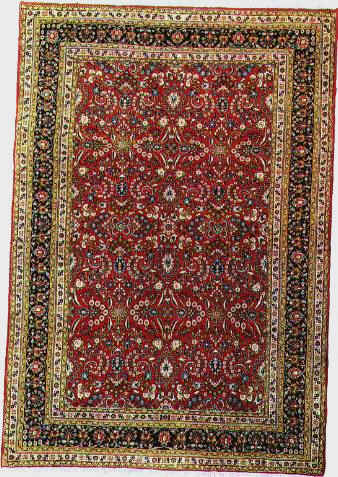|
|
In the course of time, situation is utterly changed and the organized carpet weaving in cities has transferred to villages and weaving large carpets has became limited. Whereas, Hamadan is the base place of government administrations, companies, producers and brokers of the carpet, there is some overall supervisory by this city over the region's carpet weaving. At the flourishing era of Hamadan carpet weaving and when the products of the city was mostly exported to Europe, Canada and USA. All products of Zanjan, Qazvin, Saveh, Malayer, Tuisserkan, Sanandaj and Kermanshah were collected in this city for benefit of the market.
Now the position has changed so much, Urban carpets have left their gross share to the villages, so that market procures its demand from hamlets through brokers and advance-purchasers. Some governmental organizations are also active in this business as:
- Carpet Company of Iran
- Hamadan hand-made Carpet Cooperative
Carpet weaving in Villages
Carpet weaving is common in many villages of Hamadan. Carpets are very different in this part considering design and quality. Carpet weavers mostly utilize the best hand spun wool prepared from Hamadan, Azerbaijan or Kermansh wool and dyeing them by natural colors, obtain a good skein to produce a long piled and thick-woven carpet in the villages.
Urban carpets have their own particularity and dimensions, while rustic carpets are mostly 2 zar (each zar=104cm.), zar and 1/2, 1/4, cushion, Kharak and runner. Images in rustic carpets are mostly imaginary, following the supervision of governmental institutes, pre-designed textures are now in common.
Colors used for carpets in those regions are blue, peacock indigo, greens (dark, medium and light ), reddish, madder, red, beige, yellow and brown.
In Angelas village, south of Hamadan, one may see the weavers using hand-spun native wool and madder colors. In Ein-abad and Buyuk-abad villages a considerable work of carpet weaving continues, using images of Malayer and similar designs in Ein-abad.
During 1940 decade, Famenin was one of the best carpet weavers in region, using domestic wool, and blue, green, red, madder and crimson colors, dyed in the local dyeing workshops, its accurate and regular texture had a universal fame. Color of ancient carpets of this region is bright and transparent, with a sign of local dyers.
In every village of the region, specially in Kahard, Kaj, Oman, Farsjin, Ahmad-abad, Shahanjarin, Shanjur, Kamandan, Bubuk-abad, Arablu, Sayan as well as Ghahavand City of Shara County an expanded carpet weaving goes on, in Veislu village some small desirable carpets are woven.
Bozchelu, a district between Hamadan and Arak-Malayer, in the past was producer of attractive 2 zar with Herati designs and crimson or beige color. One of the few regions which utilize curved design, under influence of Arak carpets.
In Famenin county, you may find at least 3 pieces of very ancient carpets, now, in Philadelphia Museum in Williams Collection, the other in Willieni Collection and the third preserved in Laam collection.
Precedence of carpet weaving in this part goes back to 150 years ago. Even now, in Famenin, there is sort of high technique carpet weaving and silk rugs which necessitates skill and expertise in the art.

Ghab-Qurani: 3x2 m
|
|

